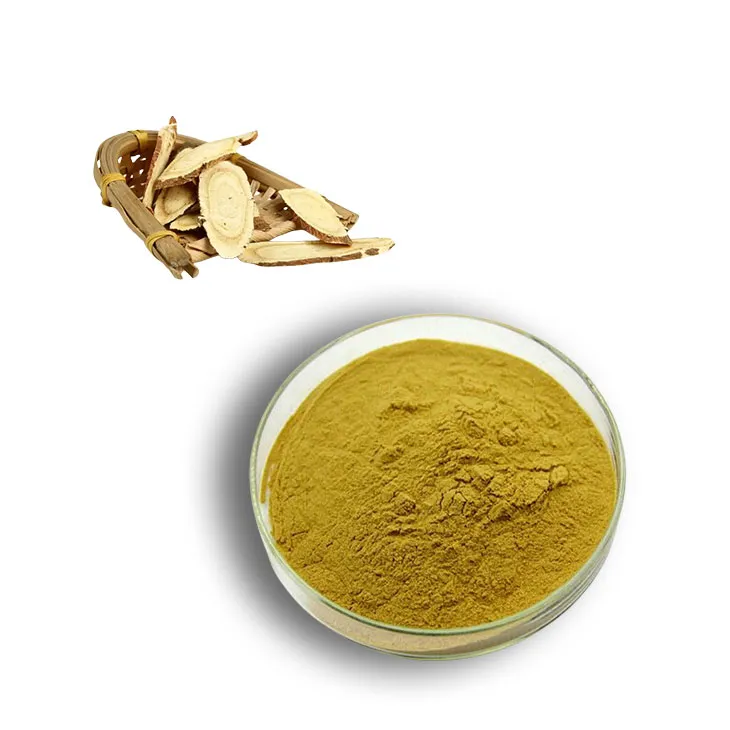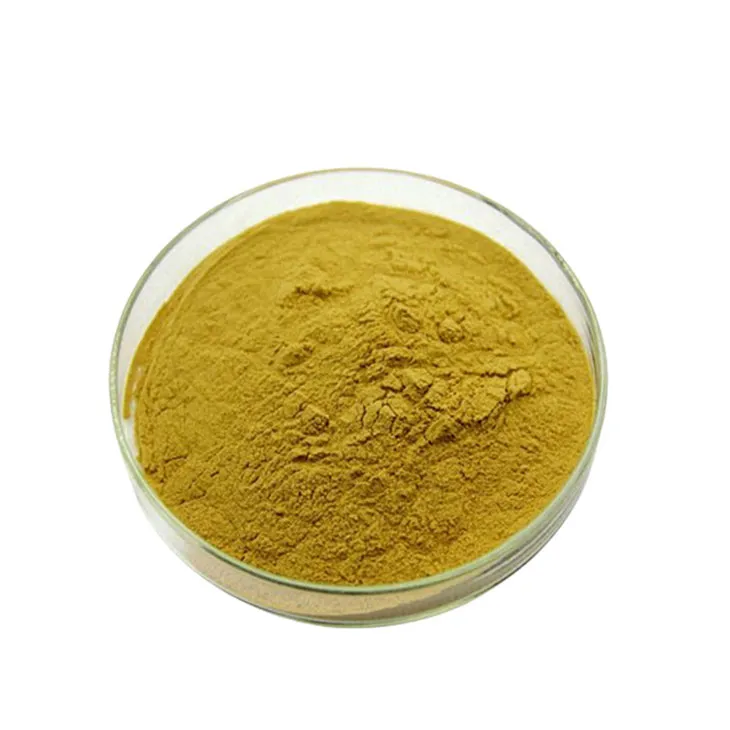- 0086-571-85302990
- sales@greenskybio.com
Production of Licorice Root Extract Powder: A Complete Guide for Consumers and Manufacturers
2024-12-16

1. Introduction
Licorice Root Extract Powder has been used for centuries in various applications, from traditional medicine to the food and cosmetic industries. This powder is derived from the licorice plant (Glycyrrhiza glabra), which is native to parts of Europe, Asia, and the Middle East. As consumers become more interested in natural products, the demand for Licorice Root Extract Powder has been steadily increasing. For manufacturers, understanding the production process, safety aspects, and market trends is crucial for success in this growing market.

2. The Licorice Plant
2.1 Botanical Characteristics
The licorice plant is a perennial herb that can grow up to one meter in height. It has pinnate leaves and purple or pale blue flowers. The root of the plant is the most valuable part, which can be thick and long, sometimes reaching several meters in length. The root contains a variety of active compounds, such as glycyrrhizin, which is responsible for the characteristic sweet taste of licorice.
2.2 Cultivation
Licorice plants are typically grown in well - drained soil in sunny locations. They can tolerate a wide range of climates but are often found in dry and semi - arid regions. The plants are usually propagated from seeds or rhizome cuttings. Cultivation requires careful management of irrigation, fertilization, and pest control to ensure healthy growth and high - quality roots.
3. Production Process
3.1 Harvesting
The roots of the licorice plant are usually harvested after 3 - 5 years of growth. This is when the root has accumulated a sufficient amount of active compounds. Harvesting is typically done in the autumn when the plant has stored most of its nutrients in the root. The roots are carefully dug out to avoid damage.
3.2 Cleaning and Preparation
Once harvested, the roots are thoroughly cleaned to remove soil, debris, and other impurities. They are then cut into smaller pieces to facilitate further processing. This may involve drying the root pieces partially to reduce moisture content.
3.3 Extraction
- There are different methods of extraction, with solvent extraction being one of the most common. Solvents such as ethanol or water are used to extract the active compounds from the root pieces.
- The choice of solvent depends on the desired end - product and the solubility of the target compounds. For example, if glycyrrhizin is the main compound of interest, a solvent that can effectively dissolve it is chosen.
- The extraction process may be carried out at different temperatures and pressures to optimize the yield of the extract.
3.4 Concentration and Drying
- After extraction, the resulting liquid extract is concentrated to increase the concentration of the active compounds. This can be done through evaporation, either under normal pressure or reduced pressure.
- The concentrated extract is then dried to obtain the Licorice Root Extract Powder. Drying methods include spray drying, freeze - drying, or vacuum drying. Spray drying is often preferred in industrial settings due to its high efficiency and ability to produce a fine powder with good flow properties.

4. Quality Control
4.1 Raw Material Inspection
Before production, the raw licorice roots are inspected for quality. This includes checking for signs of disease, pests, or improper growth. Only high - quality roots are selected for further processing.
4.2 In - process Monitoring
During the production process, various parameters are monitored to ensure product quality. For example, the extraction time, temperature, and solvent concentration are carefully controlled. In addition, the quality of the intermediate products, such as the liquid extract and the concentrated extract, is regularly tested.
4.3 Final Product Testing
- The final licorice root extract powder is subjected to a comprehensive set of tests. These include tests for the content of active compounds, such as glycyrrhizin. The purity of the powder is also determined, ensuring that there are no contaminants or excessive levels of impurities.
- Microbial testing is carried out to check for the presence of harmful bacteria, fungi, or other microorganisms. This is especially important for products intended for use in the food or cosmetic industries.

5. Safety Considerations
5.1 Glycyrrhizin and Health Concerns
While glycyrrhizin gives licorice its sweet taste, it can also have potential health effects if consumed in large amounts. High levels of glycyrrhizin may cause issues such as increased blood pressure, fluid retention, and electrolyte imbalances. Therefore, for products intended for human consumption, manufacturers need to ensure that the glycyrrhizin content is within safe limits.
5.2 Allergies
Although rare, some people may be allergic to licorice root extract. Manufacturers should clearly label their products to indicate the presence of licorice root extract to avoid potential allergic reactions in consumers.
5.3 Purity and Contaminants
As mentioned in quality control, ensuring the purity of the licorice root extract powder is crucial. Contaminants such as heavy metals, pesticides, or mycotoxins can pose serious health risks. Manufacturers must implement strict quality control measures to prevent the presence of these contaminants in their products.6. Market Trends
6.1 Growing Demand in the Food Industry
Licorice root extract powder is increasingly being used in the food industry as a natural sweetener, flavor enhancer, and antioxidant. It is used in a variety of products, including confectionery, beverages, and baked goods. The trend towards natural and clean - label products has further boosted the demand for licorice root extract powder in the food sector.
6.2 Cosmetic and Skincare Applications
In the cosmetic and skincare industries, licorice root extract powder is valued for its anti - inflammatory, antioxidant, and skin - brightening properties. It is used in products such as creams, lotions, and serums. The growing consumer interest in natural skincare products has led to an increased use of licorice root extract powder in this area.
6.3 Herbal Medicine and Dietary Supplements
Licorice root has a long history in traditional herbal medicine. Today, it is also used in dietary supplements. The demand for natural remedies and supplements has contributed to the growth of the licorice root extract powder market in this segment. However, manufacturers need to comply with relevant regulations regarding herbal products and dietary supplements.7. Conclusion
The production of licorice root extract powder is a complex process that involves multiple steps from cultivation to final product testing. For manufacturers, understanding and adhering to quality control and safety standards is essential to produce high - quality products. Consumers, on the other hand, can benefit from being aware of the production process, safety aspects, and market trends when choosing licorice root extract powder - based products. As the demand for natural products continues to rise, the licorice root extract powder market is expected to grow further, presenting opportunities for both manufacturers and consumers.
FAQ:
Q1: What are the main raw materials for licorice root extract powder production?
The main raw material is, of course, licorice root. High - quality licorice roots are carefully selected. These roots are usually sourced from regions where licorice is grown abundantly, such as certain areas in Asia and the Middle East. The roots should be free from excessive damage and contamination to ensure the quality of the final extract powder.
Q2: What are the production processes involved in making licorice root extract powder?
Firstly, the licorice roots are cleaned thoroughly to remove dirt, debris, and other impurities. Then, they are typically dried to reduce the moisture content. After that, the dried roots are ground into a coarse powder. Next, extraction methods such as solvent extraction (using solvents like ethanol or water) are employed to draw out the active compounds from the ground licorice root powder. Finally, the extract is further processed, often through evaporation and drying techniques, to obtain the licorice root extract powder in its final form.
Q3: How is the quality of licorice root extract powder controlled during production?
Quality control begins with the selection of raw materials. Only high - quality licorice roots are used. During the production process, strict monitoring of parameters such as temperature, pressure, and extraction time is carried out in the extraction step. Analytical methods like HPLC (High - Performance Liquid Chromatography) are used to analyze the composition of the extract to ensure the presence of desired active ingredients and the absence of harmful substances. Also, final product testing for factors like purity, solubility, and microbial contamination is essential to guarantee the overall quality.
Q4: What safety precautions should be considered during the production of licorice root extract powder?
When using solvents for extraction, proper ventilation systems must be in place to prevent the buildup of solvent vapors, which can be hazardous. Workers should be provided with appropriate personal protective equipment, such as gloves and masks. In addition, strict hygiene standards are necessary to avoid microbial contamination. Also, during the drying process, the temperature should be carefully controlled to prevent the formation of harmful by - products.
Q5: What are the current market trends for licorice root extract powder?
There is an increasing demand for natural and herbal products, which has led to a growth in the market for licorice root extract powder. It is being used more and more in the food and beverage industry as a natural sweetener and flavor enhancer. In the pharmaceutical and cosmetic industries, its potential health - promoting and skin - care properties are also driving its market growth. Additionally, there is a trend towards more sustainable production methods to meet the demands of environmentally - conscious consumers.
Related literature
- Production Technologies of Medicinal Plant Extracts: Licorice Root as a Case Study"
- "Safety and Quality Assurance in Licorice Root Extract Production"
- "Market Dynamics of Licorice Root Extract Powder: A Global Perspective"
- ▶ Hesperidin
- ▶ citrus bioflavonoids
- ▶ plant extract
- ▶ lycopene
- ▶ Diosmin
- ▶ Grape seed extract
- ▶ Sea buckthorn Juice Powder
- ▶ Beetroot powder
- ▶ Hops Extract
- ▶ Artichoke Extract
- ▶ Reishi mushroom extract
- ▶ Astaxanthin
- ▶ Green Tea Extract
- ▶ Curcumin Extract
- ▶ Horse Chestnut Extract
- ▶ Other Problems
- ▶ Boswellia Serrata Extract
- ▶ Resveratrol Extract
- ▶ Marigold Extract
- ▶ Grape Leaf Extract
- ▶ blog3
- ▶ blog4
- ▶ blog5
-
Pure 85% Tomentil Extract.
2024-12-16
-
American Ginseng Root Extract
2024-12-16
-
Hawthorn Extract
2024-12-16
-
Phyllanthus Emblica Extract
2024-12-16
-
Elderberry Extract
2024-12-16
-
Marigold Extract
2024-12-16
-
Buckthorn bark extract
2024-12-16
-
Motherwort Extract
2024-12-16
-
Resveratrol extract
2024-12-16
-
Carrageenan Extract Powder
2024-12-16
-
Polygonum multiflorum extract
2024-12-16





















